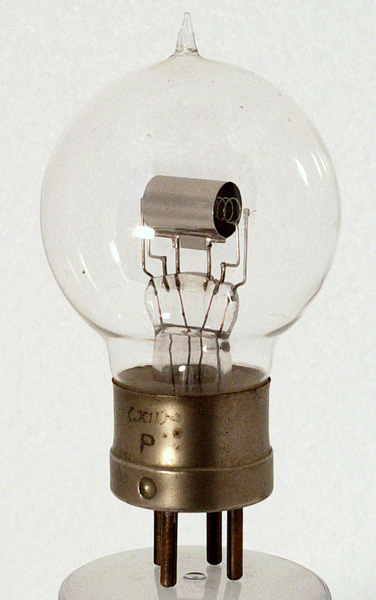|
R TypeSensibly equivalent¶ to:See also:
|
|
|

|
This beautiful 'R' exhibit is not of UK manufacture. Its neat type of pinch seal and very clear glass are typical of Dutch valves (ie. made by Philips and its associated companies) imported under various brand names during the mid 1920s. There were many types of Dutch valve, some of which looked externally similar so this one might or might not be equivalent to the British Type R.Dutch valves usually carry rather small and insignificant type number markings and the early Philips type nomenclature was odd, to say the least (Roman numerals, etc.). It would not be surprising if the markings seen stamped on the base cap designate a type number in the Philips system.The glass pinch to hold the electrode structure in place is clearly flattened into a fish tail, the electrodes are aligned horizontally and held at either end by the wires in the pinch.The filament, in our exhibit, is burnt out but what is left shows that it was a single thin strand of tungsten wire held on the centre axis of the anode cylinder. The grid can be seen in the picture and consists of a bright wire helix that is held firm on the long axis by being bonded to a rod passing lengthways through the anode cavity. Normally the grid was made to have 11 turns of 0.13mm wire with an overall diameter of about 5 mm. The anode is a bright metal cylinder about 16 mm long and close to 10 mm in diameter, rigidly held at both ends. The anode is probably made of nickel sheet.The envelope is marked 4 Volts filament and 60-100 Volts anode. The amplification factor, or μ, was in the region of 9, but all parameters varied quite widely from sample to sample and manufacturer to manufacturer.The R valve was developed from the French hard vacuum valve of WW1 and was made in the UK from 1916. Its use in new equipment declined in 1925 with the introduction of the lower power dull emitter valves.The balloon envelope is 52 mm in diameter and, excluding the B4 base pins, is 88 mm tall.References: Private communication, 1005 & 1003. Type R Type was first introduced in 1916. See also 1916 adverts. |
Pin Connections
| 1 | 2 | 3 | 4 |  a | g1 | f | f |
|
|
Absolute Maximum Operating Conditions¶
| Vh | Ah | Va | ra | gm | 
| 4.0 | 0.7 | 100 | 40k | 0.26 |
|
Updated January 08, 2013.
|
|